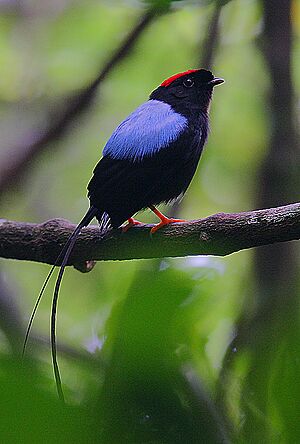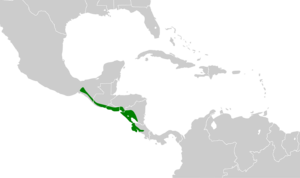Long-tailed manakin facts for kids
Quick facts for kids Long-tailed manakin |
|
|---|---|
 |
|
| Conservation status | |
| Scientific classification | |
| Genus: |
Chiroxiphia
|
| Species: |
linearis
|
 |
|
The long-tailed manakin (Chiroxiphia linearis) is a small, plump bird found in Central America. These birds live in both wet and dry tropical forests. Males are easy to spot with their black feathers, bright blue backs, and red crowns. They also have two very long tail feathers! Females and young birds are mostly olive-green. When it's time to find a mate, male long-tailed manakins work together. They perform a special, coordinated dance to attract females. This bird is quite common and lives in many places, so its conservation status is considered "least concern".
Contents
What Does the Long-tailed Manakin Look Like?
The long-tailed manakin is a small bird, about 10 centimetres (4 in) long. That's about the length of an adult's finger! It weighs around 18 grams (1 oz), which is lighter than a few coins.
Male and Female Differences
Male long-tailed manakins are mostly a deep black color. They have a bright red crown on their head and bright red legs. Their back is a striking blue. The two feathers in the middle of their tail are very long and thin.
Female long-tailed manakins look different. They are mostly olive-green. Their underside, chin, and throat are a lighter green. Sometimes, a female might have a small bit of red on her crown too.
Similar Birds
This manakin looks a lot like a few other birds in its family. These include the lance-tailed manakin, blue-backed manakin, swallow-tailed manakin, and Yungas manakin. All these birds have a red crown and a blue back. However, the long-tailed manakin lives in different areas, so you won't find them living in the same places as these other species.
Where Do Long-tailed Manakins Live?
The long-tailed manakin lives in several countries in Central America. You can find them in Costa Rica, El Salvador, Guatemala, Honduras, Mexico, and Nicaragua.
Habitat of the Manakin
These birds prefer certain types of places to live. Their natural habitats include dry tropical forests and moist lowland tropical forests. They can also be found in areas that were once forests but have changed a lot due to human activity.
Reproduction and Life Cycle
Manakin species have very interesting family lives. Male long-tailed manakins often form partnerships, usually in pairs or trios. They work together to sing in perfect harmony.
The Courtship Dance
When a female bird is attracted by their singing, the male partners perform a complex, coordinated dance. This special dance is how they try to impress the female. If the female decides to mate, only the main male in the partnership will be the father.
Raising the Young
In many groups of displaying males, only one or a few males will be responsible for most of the baby birds in a breeding season. After mating, the female builds the nest all by herself. She also raises the young birds without any help from the males.
Conservation Status
The long-tailed manakin is a bird with a very large range. It is also quite common in the areas where it lives. Scientists believe that the total number of these birds is very large.
Population Stability
The number of long-tailed manakins seems to be stable, meaning it's not going up or down quickly. Because of its wide range and stable population, the International Union for Conservation of Nature has given this bird a conservation status of "least concern". This means they are not currently worried about this species becoming endangered.


